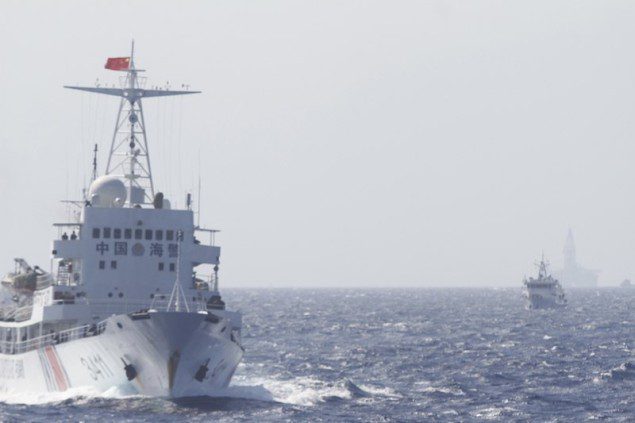Chinese
Coast Guard ships are seen near Chinese oil rig Haiyang Shi You 981 in
the South China Sea,
about 210 km (130 miles) off shore of Vietnam May
14, 2014. REUTERS/Nguyen Minh
Territorial disputes over tiny islands and reefs in the South China Sea are poisoning relations between China and its neighbours in Southeast Asia.The part of the headline in quotation marks is not to be found in the story, rather it is from a 1382 letter sent by Japan’s Prince Kanenaga to the Hongwu Emperor of China, founder of the Ming Dynasty, explicitly denying the legitimacy of Chinese dominance:
“In recent months, China has undertaken destabilising, unilateral actions asserting its claims in the South China Sea,” U.S. Defense Secretary Chuck Hagel told an audience in Singapore last month.
“(China) has restricted access to Scarborough Reef, put pressure on the long-standing Philippine presence at the Second Thomas Shoal, begun land reclamation activities at multiple locations, and moved an oil rig into disputed waters near the Paracel Islands,” Hagel complained at the Shangri-La Dialogue.
The defense secretary’s speech drew an angry response from China, which rebuked him for making “harsh, provocative” comments – signalling a further deterioration in the already strained relationship between the two countries.
According to Hagel, the United States takes no position on territorial disputes in the South China Sea that pit China against Vietnam, the Philippines, Malaysia and Brunei.
But Washington will oppose any attempt to use “intimidation, coercion or the threat of force to assert those claims”. It will also oppose any attempt to restrict overflight and freedom of navigation.
Washington says it wants to uphold a “rules-based order” in which disputes are settled through diplomacy, well-established norms and international law.
However, all that is threatened by long-standing disputes over the ownership of two hundred or so tiny islands, islets, shoals and cays, reefs and rocks scattered across the area.
The various outcrops cover just a few square kilometres in total. Many are only just above the waterline even at low tide. But with them come claims to regulate navigation, fish, and drill for oil and gas over much more extensive areas.
In 1974, China and South Vietnam fought a short war over one island group. In recent years, there have been frequent and worsening low-level clashes in the South China Sea, severely straining relations between China and the other littoral states.
GLOBAL CROSSROADS
The area is strategically vital. Hagel called the South China Sea “the beating heart of Asia-Pacific and a crossroads of the global economy”.
The South China Sea contains the world’s most important shipping lanes and sits astride supply routes essential to South Korea and Japan as well as China.
More than half of the world’s merchant shipping tonnage passes through the Straits of Malacca, Sunda and Lombok each year with nearly all of it continuing on through the South China Sea....MUCH MORE
Heaven and earth are vast, they are not monopolized by one ruler.For some reason I've never been able to get that quote out of my head but I promise that is as esoteric as I'll ever get.
The universe is great and wide, and the various countries are created each to have a share in its rule.
Now the world is the world's world; it does not belong to a single person.
Here's a ref. via Oxford Journals.
